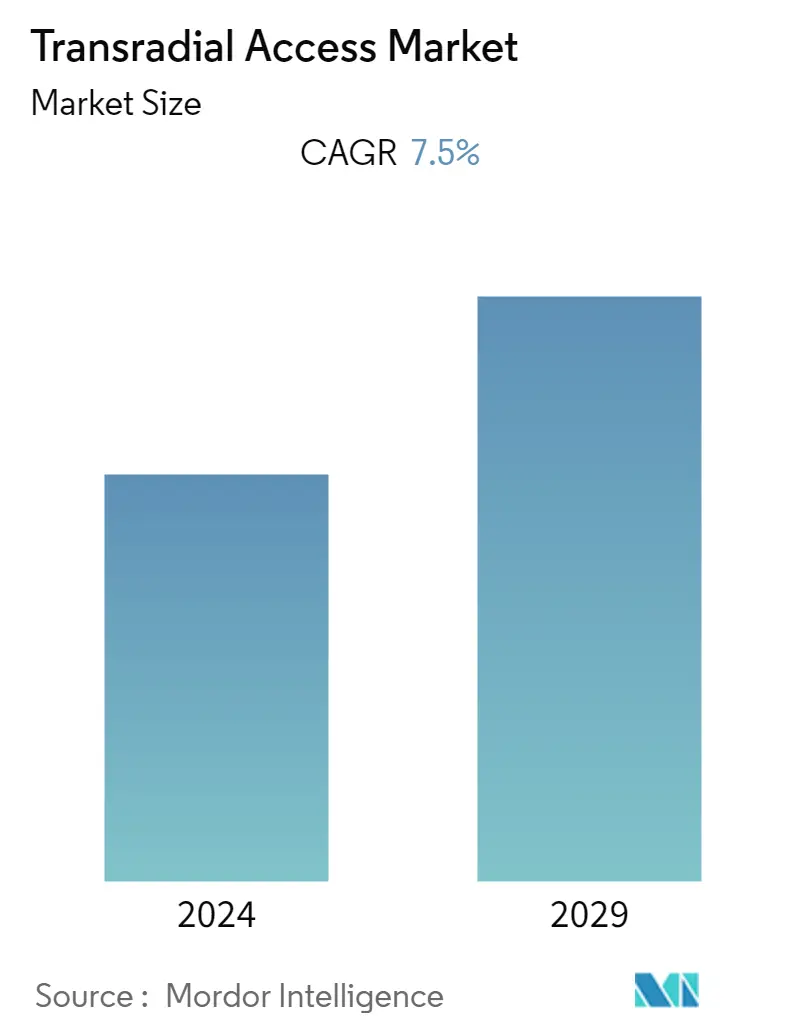Market Size of Transradial Access Industry

| Study Period | 2021 - 2029 |
| Base Year For Estimation | 2023 |
| CAGR | 7.50 % |
| Fastest Growing Market | Asia Pacific |
| Largest Market | North America |
| Market Concentration | High |
Major Players
*Disclaimer: Major Players sorted in no particular order |
Need a report that reflects how COVID-19 has impacted this market and its growth?
Transradial Access Market Analysis
The transradial access devices market is expected to register a CAGR of 7.5% over the forecast period.
The COVID-19 pandemic substantially affected the treatment and diagnostic procedures for cardiac practices owing to delayed diagnosis and multiple postponed appointments, thereby impacting the growth of the studied market for transradial access devices. Furthermore, many studies suggested that people with cardiac diseases were particularly vulnerable to COVID-19, which led to a decrease in footfalls in hospitals and diagnostic centers. For instance, according to the research study published by the NCBI in May 2021, during the COVID-19 pandemic, cardiac procedural activity in England decreased dramatically, with a deficit of about 45,000 procedures. Moreover, a study published in Frontiers in Family Medicine and Primary Care in December 2021 stated that in Germany, despite having symptoms of coronary artery disease (CAD), 9.1% of patients did not see a medical practitioner due to a fear of becoming infected with COVID-19. However, the study's findings also detailed that most patients received adequate medical care during the COVID-19 pandemic for CAD. As a result of the growing availability of cardiac diagnosis and treatments, the market is expected to be favorably influenced in the latter phase, as per the analysis.
The transradial access devices market is growing due to the increasing preference for interventional procedures using radial artery access, the growing prevalence of cardiovascular diseases due to lifestyle disorders, and the increasing use of radial access devices in pediatric patients.
According to the WHO data updated in June 2021, nearly 33.5 million people globally are suffering from atrial fibrillation (AFib), which is the most common type of serious arrhythmia. Moreover, the British Heart Foundation's report published in July 2021 reported that 7.6 million people in the United Kingdom live with heart and circulatory diseases. Further, according to the 2022 AHA report, approximately 244.1 million people were living with IHD around the world. North Africa, the Middle East, Central, and South Asia, and Eastern Europe had the highest prevalence rates of IHD in the world in 2020. With the rise in the aging population worldwide, the number of patients suffering from heart rhythm disorders is likely to increase. This will lead to increased adoption of transradial access, which is expected to drive the growth of the studied market.
A scientific study published by the AHA in August 2021 stated that lower extremity peripheral artery disease (PAD) affects more than 230 million people worldwide and is linked to an elevated risk of several unfavorable clinical outcomes (including cardiovascular diseases like coronary heart disease and stroke and limb outcomes like amputee status). The increased incidence of PAD ultimately boosts the demand for interventional procedures requiring transradial access, augmenting the market's growth over the forecast period.
However, the major restraining factor for the market's growth is the high costs involved in the placement and maintenance of vascular access devices and the lack of trained professionals, which poses significant challenges.
